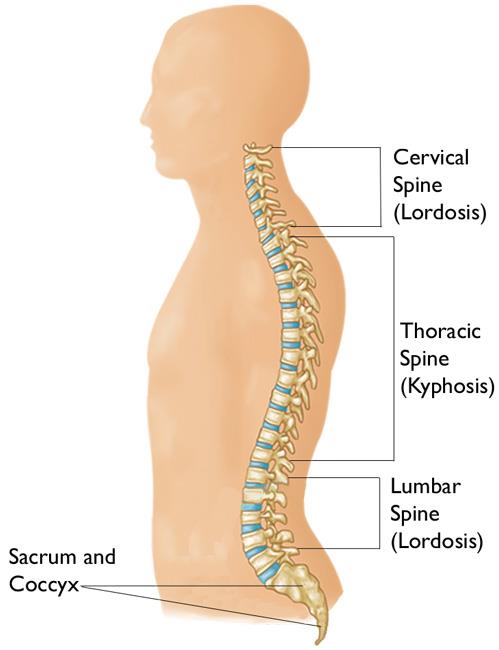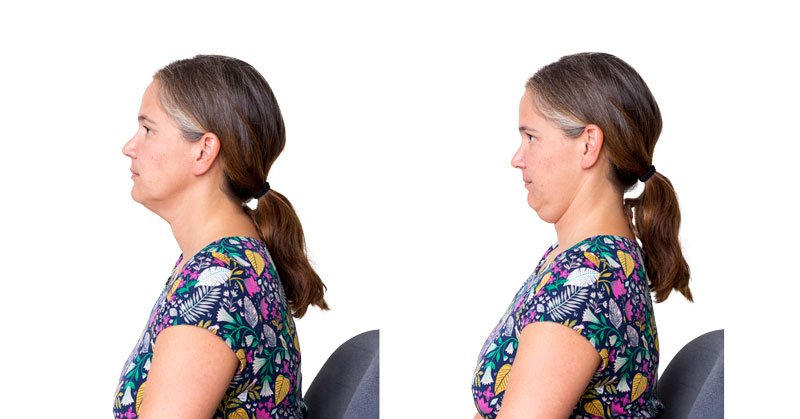Posture is the position you hold your body in when you’re sitting or standing. Over time, it can get worse, especially if you don’t regularly do exercises to maintain good posture. If you watch a 9-month old infant sit, you’ll see their posture is perfect. Their back and neck are rod-straight and their head doesn’t hunch forward or tilt to the side. As you age and are put in positions that can force poor posture, or allow you to get lazy and slouch, your posture breaks down, and you see the head- and shoulders-forward posture that’s very common. For many, it’s too late to prevent poor posture. The good news is that you can work to improve it.
Smartphone use is starting to be a major factor in poor posture too. The head-down position, often called “text neck”—that’s typical when looking at your phone—effectively trains your body into a new default posture. Text neck is starting to become more common in children as their smartphone use has increased. Researchers are starting to see more neck and back pain in kids linked to smartphone and computer use, which increases their risk of developing chronic pain when they’re adults. That’s why exercises to improve good posture are essential for strong shoulders, hips, neck, and back.
Benefits of good posture
Every muscle, bone, tendon, and ligament in your body was designed with a specific purpose. They work best when you have a “normal” posture with your body parts in the proper alignments. When your posture breaks down, it causes some muscles to become too short and tight, and others to become lengthened, weak, and loose. It’s most common in the shoulders, neck, upper back, hips, and low back, but it can also happen in your ankles and other joints.
Working to maintain good posture will go a long way to preventing neck and back pain. When everything is aligned correctly, your joints can move the way they’re designed. One of the most common shoulder injuries, called an impingement, happens when the space between your humerus (upper arm bone) and your scapula (shoulder blade) becomes too tight and pinches the rotator cuff tendon that runs through the joint. A common way the space becomes tight is from your shoulders rounding forward. This changes the alignment of the humerus and scapula, and can also limit how well the scapula moves because its supporting muscles are long and weak.
As an added benefit, good posture will help your clothes fit better too. Unless you have custom clothes, most shirts are cut so the front half and back half are about the same size. When you have rounded shoulders, it will make the back of your shirt tighter and not fit as well. That can make it hard to do things like driving where you raise your arms out in front.
For good posture, you’ll generally want to perform exercises that “stretch your front and strengthen your back.” The two exceptions are your neck (“strengthen your front and stretch your back”) and your abs (“strengthen your front”).
What’s normal posture?

Your neck and spine have normal curves in each of the 3 sections known as the cervical, thoracic, and lumbar spines.
Your cervical spine (neck) has a lordotic curve that curves gently towards the front of your body. Excessive curvature in the cervical spine is called lordosis. It leads to tight muscles in the back of your neck and weak muscles in the front. Cervical lordosis usually happens as a compensation for thoracic kyphosis—excessive curvature in your upper back—so that you can keep your eyes level instead of always looking at the ground.
Your thoracic spine (middle and upper back) has a slight kyphotic curve, where your spine curves towards the back of your body. Having too much of this curve is called kyphosis or “hunchback.” Those with kyphosis have forward-rounded shoulders caused by tight pectoral muscles in the chest and weak scapular stabilizers (rhomboids and middle and lower trapezius) in the upper back.
Upper crossed syndrome (UCS) is the common name for the combined postural deformity of cervical lordosis and thoracic kyphosis. Those with UCS have tight muscles in the back of their neck and in their chest (pectoralis major and minor). They also have weak neck flexors in the front of their neck, and rhomboids and middle and lower traps in the back.
Your lumbar spine (lower back) has a natural lordotic curve like your cervical spine. Lumbar lordosis (“swayback”) can be caused by lower crossed syndrome, where you have tight hip flexors in the front of your hips and thighs and weak hip extenders (glutes and hamstrings) in the back of your legs. This posture is very common when you spend most of your time sitting, which causes the tight front and weak back of your hips. Abdominal obesity and pregnancy are also common causes of lumbar lordosis. The extra weight carried in your belly causes a shift in your hips and spine so you can stand upright, which then leads to tight hip flexors and weak hip extenders.
Having too little curvature in your spine is called “flatback.” Relatively uncommon compared to lordosis and kyphosis, flatback is usually caused by degenerative conditions such as arthritis.
Ways to improve posture
Exercises to improve your posture follow the general rule of “stretch your front, strengthen your back.” This covers the major muscle groups that affect posture. The two exceptions are your neck (“strengthen your front and stretch your back”) and your abs (“strengthen your front”).
For UCS, the pectoralis major and minor muscles in your chest should be stretched on both sides by doing what’s called a doorway stretch. Try doing your “Ys, Ts, and Ws”: exercises to strengthen your upper back muscles (rhomboids and middle and lower trapezius). These are postural muscles, so their main function is muscular endurance to hold their proper position for long periods of time. If you don’t currently have any pain and are just trying to improve your posture, phase three of the Rx3 Shoulder program has the stretches and strengthening exercises to target these muscles.
 You can stretch and strengthen your neck with a chin-tuck exercise too. This exercise will stretch the back of your neck, especially up high at the base of your skull where those muscles have to work overtime to keep your eyes level when you’re stuck in a head-forward posture. Chin tucks will also strengthen the muscles in the front of your neck.
You can stretch and strengthen your neck with a chin-tuck exercise too. This exercise will stretch the back of your neck, especially up high at the base of your skull where those muscles have to work overtime to keep your eyes level when you’re stuck in a head-forward posture. Chin tucks will also strengthen the muscles in the front of your neck.
For lower crossed syndrome, stretch your quads and hip flexors, which are the front of your thighs and hips. Exercises such as glute bridges and planks will strengthen your glutes in the back and abs in the front. Phase 3 of the Rx3 Low Back program works to address lower crossed syndrome if you don’t currently have back pain. One thing to note about the exercises in the program: Phase 3 includes a crunch, which is different from a traditional sit-up. For the crunch, your lower back stays on the floor, and you squeeze your abs to pull your head and shoulder blades off the floor, bending forward at your mid-to-low back. This is unlike a sit-up where you’re bending at your low back and hips to touch your elbows to your knees. A sit-up mostly targets your hip flexors, which are already tight and overactive in people with lower crossed syndrome.
How long to keep doing postural exercises
Postural exercises need to be continually worked in order to maintain good posture, and not default back to a slouched, hip- and head-forward position. If you need to work on your posture, do these exercises 3–4 times a week. They should only take about 15 minutes a day if you do them all at once. You’ll start to see small improvements in a couple of weeks, and very good results in about 6 weeks. Once your posture is restored to an optimal position, you’ll only need to do the exercises a few times a week for better military wellness.




